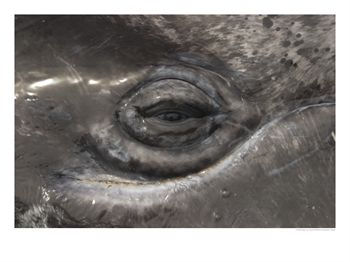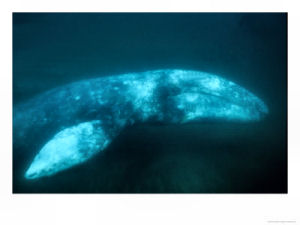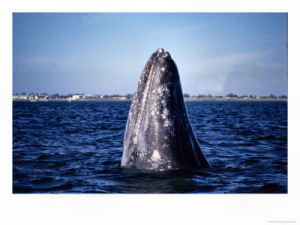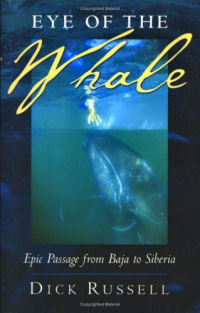California State Marine Mammal
| California Gray Whale |
Eschrichtius robustus |
Adopted:August 24, 1975 |
We begin this article about the California state marine mammal by going back in time to the mid 19th century when whalers discovered the cache of gray whales in the lagoons of Baja California (Mexico). The gray whales had migrated from the northern oceans around Alaska to mate and to give birth.
Mother gray whales nursed their young (calves) for at least six months and during this period, the mothers are extremely protective, vigorously defending their offspring against killer whales, sharks, and whalers. Aggressive attacks on perceived enemies led whalers to refer to gray whales as devilwhales or devilfish.
Whales provided many of the products in demand during the 19th century. Whale oils were used for lamp oils, lubricating oils, and candle waxes.
Baleen, the strong, flexible upper jaw appendages used for straining food from sea water by some whales, was put to many uses. Sometimes called whalebone in the fashion industry, baleen was used in lady's corsets, as hoop frames for skirts, and to stiffen collars. Baleen was also used in hat brims, as umbrella ribs, and for riding crops and buggy whips.
One raw product, sometimes produced in the intestines of sperm whales, was ambergris. Ambergris was used in fine perfumes to stabilize their scent.
High demand for these raw products led to over-hunting and the virtual extinction of gray whales in the 1880s.
The depletion of gray whales by the industry made them unprofitable to hunt and led to population increases that led to another bout of over-kill in the 1920s and 30s, when "floating factories" to process whales at sea were introduced.
The 1930s marked the beginning of international cooperation to develop regulations and protocols to ensure sustainable whale populations around the world. Perhaps the most important agreements were the International Agreement for the Regulation of Whaling adopted in the late 1930s and in 1945. This agreement was succeeded by the International Convention for the Regulation of Whaling in 1946. The International Whaling Commission was established by the 1946 agreement.
Gray whales received some protection from these two agreements and from the International Whaling Commission in 1949.
Not all nations were participants in these agreements however and gray whales were not completely safe.
In 1970, the gray whales of the Western Pacific Ocean were listed as endangered under the Endangered Species Act.
The Marine Mammal Protection Act of 1972 was enacted "To protect marine mammals; to establish a Marine Mammal Commission; for other purposes."
Though the gray whale's numbers were increasing, some harvesting of whales continued by communities not bound by treaties.
Though the gray whale's numbers were increasing, harvesting of whales continued by communities not bound by treaties. There were also claims against some countries that their practices were in violation of treaties or in violation of U.S. law in U.S. waters.
In this light and to protest the killing of marine mammals, students of Dana Hills High School *, of Dana Point, went to work to make the California gray whale the official state marine mammal of the State of California. The Dana Hill students hoped that the designation would "influence the whaling nations to uphold the International Whaling Commission moratorium and the specified quotas in whaling."
Adoption of the California State Marine Mammal
The legislation, Assembly Bill No. 258, was introduced by California Assembly member Robert E. Badham on December 13, 1974 and read for the first time on January 6, 1975.
It wasn't long before opposition to AB 258 emerged. It came from The Friends of the Sea Otter, a Santa Cruz advocacy group.
The Friends of the Sea Otter, established in 1968, is the only advocacy organization for sea otters in the world and has worked tirelessly to protect the sea otters living on the California coast. Their efforts have paid off and the population has increased to around 2,300 today.
Collecting 50,000 signatures on a petition supportive of the sea otter, The Friends of the Sea Otter made a strong case against the whale.
For one thing, they complained, the whales are migratory animals, cruising along the California coastline on their way to Mexico to give birth in November, December, and January and returning to Alaska in February. The otters live on the California coast all year long.
In the end, however, whale proponents, including the American Cetacean Society, were able to overwhelm the otter faction. It didn't hurt that the whale on the ballot wasn't just any whale. It was the "California" gray whale whose migrations drew thousands of sightseers to the coast every year.
AB 258 was approved by the Assembly (52 ayes, 7 noes) on February 27, 1975 and sent to the Senate.
Approved by the Senate (22 ayes, 3 noes) on August 7, 1975, Assembly Bill No. 258 became law on August 24, 1975 without the signature of Governor Jerry Brown.
When asked why the Governor had declined to sign the bill, a spokesman simply replied that "I think it speaks for itself."
It was filed, or chaptered, by the Secretary of State on August 25, 1775.
CHAPTER 328
An act to add Section 425.5 to the Government Code, relating to state emblems.
[Became law without the Governor's signature August 24, 1975. Filed with the Secretary of State August 25, 1975]
The people of the State of California do enact as follows:
SECTION 1. Section 425.5 is added to the Government Code, to read:
425.5 The California gray whale (Eschrichtius robustus) is the official State Marine Mammal.
A year later, Governor Brown declared that it was time to put "the whale business out of business." He explained his earlier inaction on Assembly Bill No. 258 as a decision made out of concern for the 50,000 signatures in support of the sea otter.
It's estimated that the gray whale population has increased to about 23,000 animals and, in 1994, the California gray whale became the first marine mammal to be declassified as endangered.
* Dana Hills High School in Dana Point, California has been recognized as a National Blue Ribbon School (1997/1998), as a one of the most remarkable high schools in the State of California (1990s and 2005), as one of the best schools in America by Newsweek (2005), and one of the top high schools in the country by U.S. News and World Report (2008).
California Law
The following information was excerpted from the California Government Code, Title 1, Division 2, Chapter 2.
CALIFORNIA GOVERNMENT CODE
TITLE 1. GENERAL
DIVISION 2. STATE SEAL, FLAG, AND EMBLEMS
CHAPTER 2. STATE FLAG AND EMBLEMS
SECTION 420-429.8
425.5 The California gray whale (Eschrichtius robustus) is the official State Marine Mammal.
Source: California State Legislature, California Law, , March 18, 2008.
Source: California State Legislature:Assembly Chief Clerk, Final History - 1975 - 76 Session, March 31, 2008.
Source: California State Legislature:Assembly Chief Clerk, Statutes and Amendments to the Code - 1975, March 31, 2008.
Source: The Modesto Bee & News-Herald, August 8, 1975. Page 42.
Source: The Modesto Bee & News-Herald, September 9, 1975. Page 42.
Source: The Fresno Bee, November 22, 1976. Page 2.
Source: State Names, Seals, Flags and Symbols: A Historical Guide Third Edition, Revised and Expanded by Benjamin F. Shearer and Barbara S. Shearer. Greenwood Press; 3 Sub edition (October 30, 2001).
Additional Information
Gray whale photographs:
A collection of photographs from natural history photographer and writer Phillip Colla.
Gray Whale Tutorial:
What is a California gray whale? What do they eat? When do they migrate? You can find out all about gray whales from this tutorial provided by the San Luis Obispo County Office of Education.
Gray Whale (Eschrichtius robustus):
American Cetacean Society Fact Sheet.
Marine Mammals:
Online booklet about marine mammals, including a section on the gray whale, from the California Department of Fish and Wildlife.
Fun Whale Facts:
From the Oregon Parks & Recreation Department: Whale Watching Center.
Gray Whale (Eschrichtius robustus):
From the National Marine Sanctuaries.
Gray Whale Watching in Big Sur:
Information about whale migrations and when to watch.
ACS Cetacean Curriculum:
This curriculum is intended as a resource for teachers interested in introducing their students to whales, dolphins and porpoises. It contains some basic background information on cetaceans and offers some ideas for activities to engage students.
Eye of the Whale: Epic Passage From Baja To Siberia,
by Dick Russell, 688 pages, Island Press; 1 edition (September 20, 2004) Thrilling whale watchers, stumping scientists and reminding environmentalists of the fragility of our ecological balance, the mysterious, massive gray whale takes an epic and emotional place in our hearts and minds. Here Russell, an environmental journalist best known for sparking a movement to save the Atlantic striped bass, makes a passionate argument for the protection of California grays, dubbed "whales of passage" by the 19th-century whaler and naturalist Charles Melville Scammon.
Field Guide to the Gray Whale,
by Oceanic Society, 50 pages, Sasquatch Books; Rep Sub edition (January 22, 2002) This handy 50-page booklet is the first and only practical guide to viewing the biannual migration of gray whales along the Pacific Coast. It includes fascinating information about the natural history and habits of the gray whale as well as maps and directions to whale watching sites from Alaska to Baja. Proceeds of this book help support the Oceanic Society.
Sightings: The Gray Whales' Mysterious Journey,
by Linda Hogan and Brenda Peterson, 286 pages, National Geographic Society (July 2003) Sightings is a story of tribal people, scientific researchers, fishermen, and the everyday inhabitants of the small, coastal communities whose lives are centered on the gray whale migration. A journey through water and time, Sightings is a masterful observation of one of the Earth's most enchanting creatures.
Saving the Gray Whale: People, Politics, and Conservation in Baja California ,
by Serge Dedina, 186 pages, University of Arizona Press (February 2000) Focusing on the conservation of gray whales in Mexico, Dedina (geography, Univ. of Arizona) describes the natural history and life cycles of these animals, their habitat, and the human ecology of Scammon's Lagoon and San Ignacio Lagoon in Baja California.
Gray Whales (World Life Library : Nature),
by Jim Darling, Children, grade 6 and up, 50 pages, Voyageur Press (December 5, 1999) Informative and easily outpaces comparable titles in its depth of scientific reportage. The conversational text covers physiology, habits, habitats, and, of course, migration. A section on gray whale/human interaction and a fact sheet are included. The book is graced with numerous large, full-color photos of these cetaceans plowing through the blue Pacific waters, following patterns of life that have been set in place for centuries.
|







